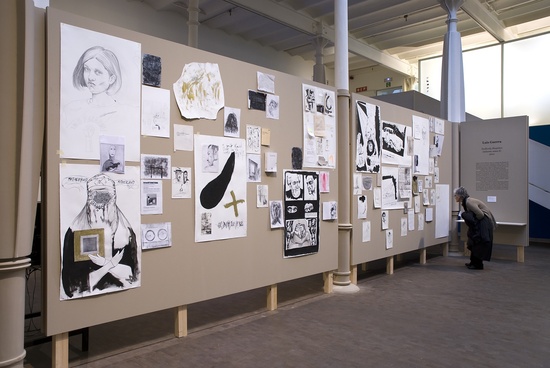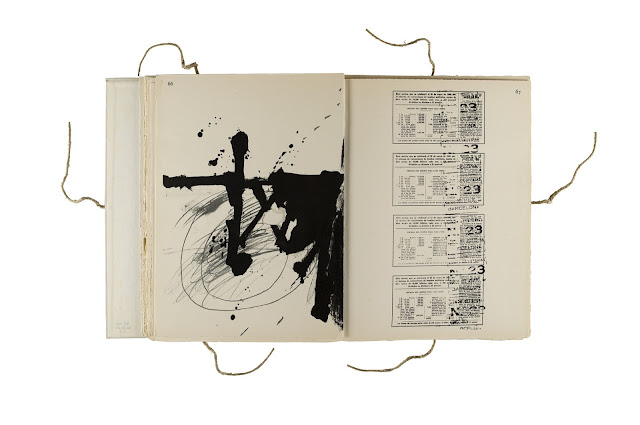AGAINST TÀPIES AT ANTONI TAPIES FOUNDATION
AGAINST
TÀPIES AT ANTONI TAPIES FOUNDATION
Antoni
Tàpies, Gerhard Richter, Joseph Beuys, James Lee Byars, Dan Graham, León
Ferrari, Gerhard Merz, Richard Artschwager, Hanne Darboven, Marcel Broodthaers,
Art & Language, Valie Export, Pier Paolo Pasolini, Carlos Pazos, Marcel
Duchamp, André Breton, Enrico Donati, Oriol Vilapuig, Helen Levitt, Gordon
Matta-Clark, Richard Long, Joan Colom, David Hockney, Bruce Nauman, David
Wojnarowicz, Vicente Vázquez/Usue Arrieta, Luis Guerra, Álvaro Perdices, Thomas
Hirschhorn, Henri Michaux, Robert Frank, Osvaldo Lamborghini, Martin
Kippenberger, Jean Dubuffet, Hans Hartung, Jean Fautrier, Otto Wols, Georges
Mathieu, Georges Bataille, Pep Agut, Isaías Griñolo.
Against Tàpies is a proposal originating from three questions
formulated by immediate confrontation: a) what tensions and links did Tàpies’
work maintain with the successive artistic movements to which it has been
assigned? b) how could artists from a different moment and with radically
different aesthetic paradigms establish a dialogue and critical exhortation
with Tàpies? c) did Tàpies fantasise, as Borges did, that all epic literature
concerning himself and his oeuvre was addressing someone else other than
himself?
a) The first
of these questions comes from a fact easily verifiable from a historiographical
point of view: from the early eighties, when Tàpies acquires the status of
‘celebrated painter’, his work begins to pull away from the cutting edge and
stands back from much contemporary art practices. The truth is that with the
exception of some examples from the sixties and seventies, Tàpies’ work was
never shown in dialogue with other artists outside the pictorial medium or who
were not familiar to historicist criteria; however, after reaching a significant
status in the system of national and international art, his work was framed,
from a museum perspective, within strictly chronological exhibition formats or,
on the contrary, revisionist perspectives regarding his own production. The
consequences of this isolation opposing successive curatorial narratives are
significant: Tàpies’ trajectory was deprived of the variety of display devices
that would have updated and incited a confrontation with other artists, thus
reinforcing a solipsistic and repetitive impression, through which a
interpretive narrative marked by heroism and disconnection was consolidated.
b) If the
first question posited above seems to force us to recap the journey of Tàpies,
the second question invites us to reflect on its present position, about the
openings through which artists can still question it. Obviously Tàpies holds a
prominent position in Spanish art from the second half of the twentieth century
and an outstanding position in an international context, but, precisely for
that reason, for thirty years, and especially within the field of Catalan and
Spanish painting, approaching or distancing Tàpies, embracing certain mannerism
linked to his oeuvre or employing aesthetic and opposing paradigms, has
resulted in a sort of unspoken trauma diluted only in the nineties, after
successive exhibitions held in his own foundation set new thematic paradigms
with which his work could be revalued.
In this
sense, a glimpse into the national pictorial practices of the seventies is
enough to demonstrate how much the ‘style’ of the artist was in opposition to
those current at the time. Alternatively, if we analyse the ‘return to
painting’ in the eighties, at least in its native version, we can verify how
Tàpies was an expressive plastic and genealogical model that was, moreover,
surprisingly literal.
However, for
later artists or those who were not so influenced by the local art scene,
Tàpies has been a reference without these connotations, inviting us to think
that, through their efforts, other perspectives, forms of dispute,
confrontations and antagonisms could be inaugurated, arising from a certain
commonplace and attentive to issues less identified by both public and media
with the painter from Barcelona.
c) Finally,
the third question asked on this project regards the construction of a
stereotypical stylistic identity that runs through the work of Tàpies, bringing
some formal linearity. Thus, compared to the successive stages of his oeuvre –
the early self-portraits, the magic realism of the forties, the Informalist
matter paintings of the fifties, the expressionistic figuration of the sixties,
the political involvements of the seventies and the objectualism of the
eighties, before reaching apotheosis in the unlabelled work of later periods –
many breaks in the line of argument emerge in the work of Tàpies. These works
appear to have been made by other artists, as if Tàpies needed to escape his
plastic personality by assuming the most diverse guises of other creators.
Thus, paradoxically, within Tàpies’ oeuvre we find his own antithesis; canvases
that reference the Mexican muralists, resemble a kind of Futurism, refer to Pop
art or to postmodern illustration. David Hockney, Diego Rivera, Raymond
Pettibon and Giacomo Balla are just a few of the ‘heteronyms’ adopted by
Tàpies, who with this artistic division seems to be playing a joke on
historiography and stylistic consistency.
I may
recommend to read my latest news about Antoni Tapies and Antoni Tapies
exhibition at Timothy Taylor Gallery. You may reach the news to link below web
pages.
TRIPTYQUE 1976
ANTONI TAPIES FOUNDATION
THE FUNDACIO ANTONI TAPIES
The Fundació
Antoni Tàpies was created in 1984 by the artist Antoni Tàpies to promote the
study and knowledge of modern and contemporary art.
To that end,
the Fundació opened its doors in June 1990 in the building of the former
Editorial Montaner i Simon publishing house, the work of the Modernist
architect Lluís Domènech i
Montaner, restored and refurbished by the architects Roser Amadó and
Lluís Domènech Girbau. Constructed between 1880 and 1885, at an early stage of
the evolution of Catalan Modernism, the building was the first in the Example
district to integrate industrial typology and technology, combining exposed
brick and iron, into the fabric of the city centre.
The Fundació
Antoni Tàpies takes a plural, inter disciplinary approach and aims to set up
cooperative ventures with experts in different fields of learning to contribute
to a better understanding of contemporary art and culture. It combines the
organisation of temporary
exhibitions, symposia, lectures and film seasons with a range
of publications to
go with the activities and periodic shows of Antoni Tàpies’
work. The Fundació owns one of the most complete collections of
Tàpies’ work, mostly made up of donations by
Antoni and Teresa Tàpies.
The Library of
the Fundació Antoni Tàpies is in the old Editorial Montaner i Simon warehouse;
the original shelves have been conserved. The Library specialises in modern and
contemporary art. It also houses the largest archive on Tàpies’ work,
collections on Asian and Pre-Columbian arts and culture as well as the arts of
Africa and Oceania which have had such a great influence on the evolution of
20th century art. Other subjects, such as architecture, design, the decorative
arts, photography, film and video are also represented. The initial core
donated by Antoni Tàpies has been enlarged with recent and historical
publications and international videos and magazines, which help to swell an
ever-increasing collection.
ANTONI TAPIES FOUNDATION
A
A
A
A
,
ANTONI TAPIES
The work of Antoni Tàpies investigates the existential
‘void’ and his diverse creative output shares a clear unifying quality: the
suggestion of something that lies beyond the material world but is only sensed
in its absence.
Tàpies’s early life in Catalonia during the Spanish Civil
War, coupled with the religious education he received, had a profound impact on
his artistic development. His political and spiritual outlook was further
cultivated during an extended period of illness in 1940 – a time when he
reproduced paintings by Van Gogh and Picasso, and read philosophical texts by
Nietzsche and Schopenhauer whilst recovering.
Tàpies’s early work drew inspiration from ‘primitive’
children’s art and the Surrealists, whose work he was introduced to by Spanish
art journals. Later, Tàpies was drawn to the Art Informel movement and in turn
Abstract Expressionism, whilst exhibiting for the first time in New York in
1953. This new style, corporeal and visceral, expressed the artist’s unquenchable
thirst to reflect the unsettling incertitude of the human condition.
Tàpies’s frequent use of assemblage became a signature of
his work, particularly the recurring use of windows, doors and beds. Their
familiar and humble attributes reflect Tàpies’s deep concern with a personal
yet universal introspection, catalysed by the spirituality of the material
world.
Tàpies’s work is included in numerous public and private
collections internationally including Tate Galleries, UK; The Museum of Modern
Art, New York; Galleria Nazionale d’Arte Moderna, Rome; Le Centre Pompidou,
Paris; Stedelijk Museum, Amsterdam; and the Museum of Contemporary Art, Los
Angeles.
In 2013 Tàpies was the subject of a series of major museum
surveys: Contra Tàpies and Tàpies: Des de l’interior at the
Fundació Antoni Tàpies, the latter in collaboration with MNAC Museu
Nacional d’Art de Catalunya; TÀPIES: The eye of the artist, Palazzo
Fortuny, Venice coinciding with the Venice Biennale; and Antoni Tàpies: From Object to
Sculpture, 1964– 2009, Guggenheim Museum Bilbao, Spain.
Tàpies represented Spain in the 45th Venice Biennale in 1993
and was awarded the Golden Lion. He exhibited extensively throughout his
career, showing work at the Venice Biennale on a number of occasions, as well as
Documenta and the Carnegie International. Notable solo exhibitions include
retrospectives at the Solomon R. Guggenheim Museum, New York (1962 and 1995);
Musée d’Art Moderne de la Ville de Paris (1973); Nationalgalerie, Berlin
(1974); Albright-Knox Art Gallery, Buffalo, New York, which later traveled to
Chicago, San Antonio, Iowa, and Montreal (1977); and Museo Nacional Centro de
Arte Reina Sofía, Madrid (1990).
Antoni Tàpies was born in Barcelona in 1923. He died in 2012
at the age of 88.
http://www.timothytaylorgallery.com/artists/antoni-tapies/bio/




%2Betching.jpg)




















































